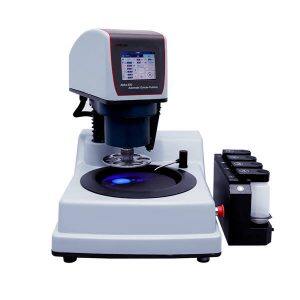What are the essential pieces of equipment commonly found in a metallographic lab for sample preparation and analysis?
Cutting Machines: These machines are used to section large pieces of metal into smaller, manageable samples for further processing. They can be abrasive or precision cutting tools, depending on the required sample size and accuracy.
Mounting Presses: Mounting presses are used to embed metal samples in a thermosetting resin, which is then hardened to create a solid block. This process facilitates easier handling, grinding, polishing, and microscopy.
Grinding and Polishing Machines: These machines are essential for preparing metal samples by sequentially grinding and polishing them to achieve a smooth, flat surface. This step is critical for obtaining accurate microstructural information during microscopy.
Etching Stations: Etching stations are used to chemically treat the polished metal samples. This process, called etching, reveals the microstructure by selectively attacking different phases of the material, making it visible under a microscope.
Microscopes: Optical microscopes are commonly used to examine metal samples at various magnifications. These microscopes reveal details about the sample’s microstructure, grain boundaries, inclusions, and defects.
Scanning Electron Microscopes (SEM): SEMs provide high-resolution images of the sample’s surface using electron beams, allowing for detailed microstructural analysis and elemental mapping.
Energy Dispersive X-ray Spectroscopy (EDS): This attachment for electron microscopes enables elemental analysis by detecting X-rays emitted when the sample is bombarded with electrons.
Image Analysis Software: With the integration of digital imaging, specialized software is used to analyze and measure various microstructural features such as grain size, phase distribution, and porosity.
Hardness Testers: These instruments determine a material’s hardness by measuring its resistance to indentation. This information helps assess the mechanical properties of the material.
Sample Cleaning Equipment: Cleaning equipment like ultrasonic baths and microabrasive cleaners are used to remove debris, residues, and contaminants from the sample surface before analysis.
Safety Equipment: Personal protective equipment (PPE), fume hoods, and safety goggles are essential to ensure the safety of lab personnel when working with chemicals and machinery.
Documentation Tools: Cameras, image capture devices, and labeling systems are used to document the samples before and after analysis for future reference.
How does the choice of metallographic lab equipment, such as microscopes and polishing machines, impact the accuracy and quality of material analysis?
Microscopes:
Optical Microscopes: The quality of optical microscopes, including their magnification range, resolution, and illumination, affects the level of detail visible in the microstructure. Higher-quality microscopes with advanced optics provide clearer and more accurate images, enabling better identification of microstructural features.
Scanning Electron Microscopes (SEM): SEMs offer higher magnification and depth of field compared to optical microscopes. The choice of SEM can impact the quality of the images produced and the resolution of surface features, influencing the accuracy of surface morphology analysis.
Transmission Electron Microscopes (TEM): TEMs provide even higher magnification and the ability to analyze thin sections of samples. The choice of TEM affects the resolution and contrast in the images, impacting the accuracy of nanoscale analysis.
Polishing Machines:
Grinding and Polishing Quality: The precision and consistency of grinding and polishing machines impact the flatness and surface quality of the sample. Inaccurate grinding or polishing can introduce artifacts, such as scratches or deformation, that may affect the accuracy of microstructural analysis.
Polishing Parameters: The choice of polishing parameters, such as applied pressure, abrasive type, and duration, influences the surface finish. Improper parameters can lead to inadequate surface preparation, making it difficult to observe microstructural details accurately.
Automation and Reproducibility: Advanced automated polishing machines offer consistent and reproducible results, reducing human error. The choice of automated systems can improve the reliability and quality of material analysis.
Sample Preparation:
Mounting Material: The choice of mounting material affects the preservation of the sample’s original structure. Inappropriate mounting materials can introduce gaps, voids, or artifacts that may impact microstructural analysis accuracy.
Etching Solutions: Different etching solutions reveal specific microstructural features. The choice of etchant impacts the visibility of grain boundaries, phases, and defects, directly affecting the accuracy of material characterization.
Sample Handling and Imaging:
Stage and Manipulation Accuracy: In microscopes, the accuracy of stage movement and sample manipulation impacts the ability to focus on specific regions of interest. Precise control is crucial for accurate analysis and measurements.
Digital Imaging Quality: The quality of cameras and imaging systems used with microscopes impacts the resolution and fidelity of digital images. High-quality imaging equipment ensures accurate documentation of microstructural features.
Data Analysis Software:
Image Analysis Algorithms: The accuracy of software algorithms used for measuring grain size, phase distribution, and other microstructural parameters depends on the quality of the software and the quality of the input images.
Quantitative Analysis Tools: Software used for quantitative analysis of microstructural features needs to be accurate and reliable to ensure the validity of the obtained results.



